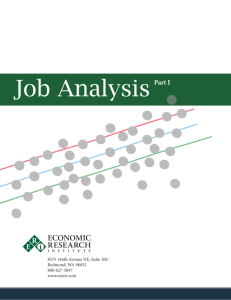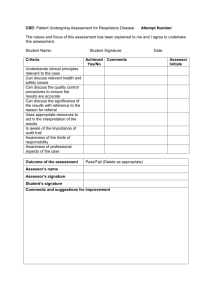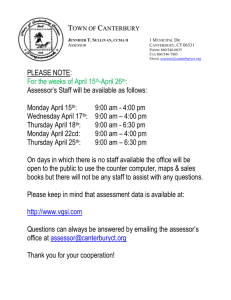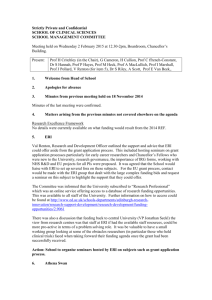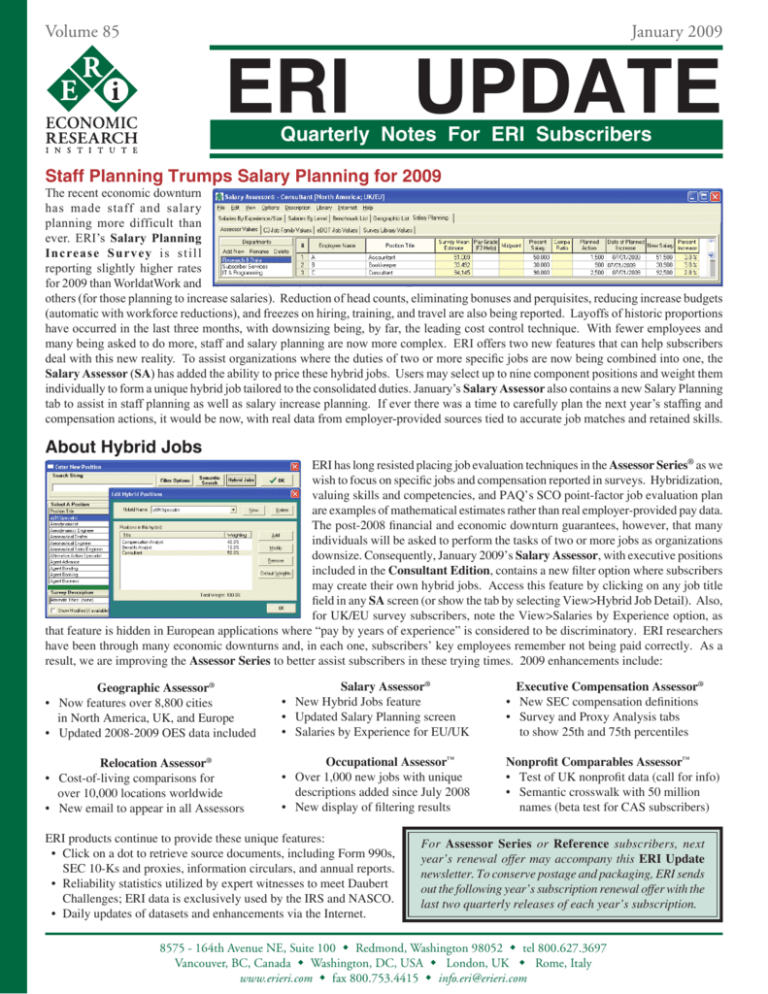
Volume 85
January 2009
ERI UPDATE
Quarterly Notes For ERI Subscribers
Staff Planning Trumps Salary Planning for 2009
The recent economic downturn
has made staff and salary
planning more difficult than
ever. ERI’s Salary Planning
I n c re a s e S u r v e y i s s t i l l
reporting slightly higher rates
for 2009 than WorldatWork and
others (for those planning to increase salaries). Reduction of head counts, eliminating bonuses and perquisites, reducing increase budgets
(automatic with workforce reductions), and freezes on hiring, training, and travel are also being reported. Layoffs of historic proportions
have occurred in the last three months, with downsizing being, by far, the leading cost control technique. With fewer employees and
many being asked to do more, staff and salary planning are now more complex. ERI offers two new features that can help subscribers
deal with this new reality. To assist organizations where the duties of two or more specific jobs are now being combined into one, the
Salary Assessor (SA) has added the ability to price these hybrid jobs. Users may select up to nine component positions and weight them
individually to form a unique hybrid job tailored to the consolidated duties. January’s Salary Assessor also contains a new Salary Planning
tab to assist in staff planning as well as salary increase planning. If ever there was a time to carefully plan the next year’s staffing and
compensation actions, it would be now, with real data from employer-provided sources tied to accurate job matches and retained skills.
About Hybrid Jobs
ERI has long resisted placing job evaluation techniques in the Assessor Series® as we
wish to focus on specific jobs and compensation reported in surveys. Hybridization,
valuing skills and competencies, and PAQ’s SCO point-factor job evaluation plan
are examples of mathematical estimates rather than real employer-provided pay data.
The post-2008 financial and economic downturn guarantees, however, that many
individuals will be asked to perform the tasks of two or more jobs as organizations
downsize. Consequently, January 2009’s Salary Assessor, with executive positions
included in the Consultant Edition, contains a new filter option where subscribers
may create their own hybrid jobs. Access this feature by clicking on any job title
field in any SA screen (or show the tab by selecting View>Hybrid Job Detail). Also,
for UK/EU survey subscribers, note the View>Salaries by Experience option, as
that feature is hidden in European applications where “pay by years of experience” is considered to be discriminatory. ERI researchers
have been through many economic downturns and, in each one, subscribers’ key employees remember not being paid correctly. As a
result, we are improving the Assessor Series to better assist subscribers in these trying times. 2009 enhancements include:
Geographic Assessor®
• Now features over 8,800 cities
in North America, UK, and Europe
• Updated 2008-2009 OES data included
Salary Assessor®
• New Hybrid Jobs feature
• Updated Salary Planning screen
• Salaries by Experience for EU/UK
Executive Compensation Assessor®
• New SEC compensation definitions
• Survey and Proxy Analysis tabs
to show 25th and 75th percentiles
Relocation Assessor®
• Cost-of-living comparisons for
over 10,000 locations worldwide
• New email to appear in all Assessors
Occupational Assessor™
• Over 1,000 new jobs with unique
descriptions added since July 2008
• New display of filtering results
Nonprofit Comparables Assessor™
• Test of UK nonprofit data (call for info)
• Semantic crosswalk with 50 million
names (beta test for CAS subscribers)
ERI products continue to provide these unique features:
• Click on a dot to retrieve source documents, including Form 990s,
SEC 10-Ks and proxies, information circulars, and annual reports.
• Reliability statistics utilized by expert witnesses to meet Daubert
Challenges; ERI data is exclusively used by the IRS and NASCO.
• Daily updates of datasets and enhancements via the Internet.
For Assessor Series or Reference subscribers, next
year’s renewal offer may accompany this ERI Update
newsletter. To conserve postage and packaging, ERI sends
out the following year’s subscription renewal offer with the
last two quarterly releases of each year’s subscription.
8575 - 164th Avenue NE, Suite 100 Redmond, Washington 98052 tel 800.627.3697
Vancouver, BC, Canada Washington, DC, USA London, UK Rome, Italy
www.erieri.com fax 800.753.4415 info.eri@erieri.com
FACTORS AFFECTING 2009 SALARY PLANNING
Is 2009 the Year for a National Health Care Plan in the US?
Health care benefit costs continue to affect salary planning. We’ve written about this before, but with a new US Administration and
President, House of Representatives, and Senate all of the same party, many of whom ran on a platform of “health care for all,” this issue
is particularly significant. For private sector employers, it might even be
good news. ERI’s perspective is mathematical, as reflected in the “Rule
of 72.” Divide a percentage (%) into the number 72, and you get the
approximate number of years for a sum to double. Much is written about
the rise in US health care costs and executive compensation as compared
to wages. Reporters describe it in terms of politics, greed, culture, or poor
governance. It is none of those; it is simply a mathematical problem.
Executive pay increasing at 20% doubles a sum every 3+ years; health care
doubles every 7+ years at 10%; and average workers’ wages double every
24 years at 3%. In 1967, a CEO’s pay was 8 times that of the average
worker, and health care costs were but 5% of wages. Mathematically,
there are only so many dollars to be expended on employees’ labor costs.
We can debate the when and how, but someday soon the cost of employees’ health care will exceed average salary/wage costs. It is a
mathematical certainty. Evidence abounds that everyone is an expert in cost shifting, except for small and medium-sized US businesses,
especially nonprofit organizations. Few notice that the “solution” of providing health care insurance to all does not address the problem
of cost acceleration, it only distributes the growing cost across the entire population. For a potential view of the future, Switzerland
administers its mandate via the Post Office, where no mail will be delivered to anyone lacking proof of insured health coverage.
In 2000, 14% of Americans were uninsured, while today it is 16%. Logic
tells us that tens of thousands of organizations have capped or totally
dropped health care coverage for employees. Ten million additional
Americans did not become uninsured without tough-made decisions. ERI
now has 40 million digitized records of nonprofit entities’ Form 990s from
1992 to the present. Along with 300 financial metrics, these IRS forms
report three compensation values:
• compensation • benefits • allowances.
Within the benefits column, we find values that indicate when entities cut
back. That is, organizations may have “spent no more than $5,000” or
“totally dropped benefits” when values in the benefits column are less than
$1,000. With premium costs increasing at 10-22% per year, compared to
wages increasing at 3%, a flood of nonprofit organizations have dropped
health care. A tsunami is indicated, although not all forms are digitized.
2009 Salary Planning
Consulting firms and professional organizations that have surveyed their
clients or members generally agree that organizations have cut their salary
increase budgets in 2009. ERI’s findings agree, but we don’t see that
the reduction will be reflected in increase amounts. That is, if 20% of
an organization’s workforce are laid off, obviously the salary increase
budget will be reduced. This doesn’t mean that those remaining will
receive smaller increase percentages, especially if their skills are in high
demand and they are asked to do more, such as perform two jobs’ tasks
rather than one.
ERI’s Salary Planning Survey (an evergreen, ever refreshing, patented
approach) suggests that skills, and the demand and supply thereof, still
dominate salary increase decision making. Industry sector also remains
an important differentiator. The financial sector’s increase plans are
substantially reduced, and nonprofits appear devastated, while oil and
gas, energy, and utilities (with an aging workforce) report robust plans.
For the latest edition, see www.salariesreview.com/index.cfm?FuseAct
ion=MeritIncreaseSurvey.Main.
ERI’s Salary Planning Survey is free to subscribers via ERIPL.
January 2009
2
Economic Research Institute Update
Employer-provided data sources
While ERI collects all sources available, the Assessor Series consists of 100% employer-provided compensation data. PAQ Services,
ERI’s affiliate, utilizes employee-provided data, in part, for its eDOT Skills Project since work measures, such as “peer interaction,” are
best judged by employees, not necessarily by the employer. The process of including a job in the Assessor Series begins with identification
of the distinct jobs found in the US economy. The primary task of each job, under the US FLSA definition, requires unique knowledge
and ability skill sets, proven in fact by job postings, disability claimant reporting, field job analyses, and salary survey inquiries. This
identification process is tracked in a daily log and can be publicly reviewed at ERI’s Job Availability website (see www.paq.com/index.
cfm?FuseAction=home.JobAvailabilityLog). When over 250 occurrences are profiled nationally, the job is added to PAQ’s eDOT Skills
Project database for inclusion in ERI’s Occupational Assessor (OA), also called the enhanced Dictionary of Occupational Titles (eDOT®).
ERI compensation researchers and PAQ job analysts then
review ERI’s data mining of US national job postings (over 50%
are now mined and digitized with over a gigabyte of data added
daily) for any new jobs, with a focus on job description prose,
including skill/action verbs and work objects, size, and an eSIC
industry profile. Captured task descriptions are incorporated
into a job description that exactly follows the construct of the
abandoned US DOT and FLSA regulations. eDOT’s 99 Selected
Characteristics of Occupations (SCOs), including the old DOT’s
64 SCOs, are assigned by semantic matching to similar jobs.
These 99 job analyses questions/measures are then incorporated
into the following: 1) SalaryExpert’s free Salary Calculator (in
which 5 questions are asked, 3 for SCOs, and 33 sets create a
finding); 2) SalariesReview surveys (entered by HR analysts,
rather than Salary Expert’s unknown visitor or subject matter
input); 3) ERI’s Occupational Assessor’s cybernetic system
(the more subscribers use or change the data–again submitted
by subject matter experts–the better the data becomes); and 4)
the PAQ questionnaire library (in which SME field job analysts
enter data utilizing a methodology consistently used since
1974). Over time, the worker trait measures (all 64 original
DOT, plus 35 new eDOT work measures) evolve with a rate of
error illustrated to meet Daubert Challenge criteria, along with
corrected job description prose and modes. PAQ’s use of a fivemeasure ordinal scale for the two-thirds of eDOT jobs using a
three-measure ordinal scale allows both an additional high and
low measure, creating a quantitative environment in which the
Central Limit Theorem applies. Leased by PAQ exclusively to
ERI for use in the Occupational Assessor, a legacy hardcopy
volume in PDF format is created at the end of each year with
preface and appendix content (A&B) matching the 1991 DOT
and accompanying 1993 SCO volumes. The 2009 DOT and
SCO volumes will be the first “legacy” volumes published. A
similar salary, demographic, and cost-of-living legacy report,
ERI’s 2009 Geographic Reference Report (GREF), has been
published annually since 1987. A 2009 International Reference
Report (IREF) complements the GREF.
These new jobs are then added one at a time to the described
SalariesReview database, ERI Salary Surveys, and the affiliate Abbott, Langer Association Surveys (ALAS). The latter two surveys are
traditional online and/or hardcopy salary surveys with input contributed by HR analysts. SalariesReview surveys have existed since 1998,
with an online methodology patent won in March 2005 (Patent No. US 6,862,596). Conducted annually since 1967, the ALAS surveys
are niche efforts, including food manufacturing, geotechnical consulting, and others, but mainly nonprofit and association related reports.
ERI’s Occupational Assessor captures last claimed salaries for disabled claimants and also contributes this data to the SalariesReview
survey database. Unlike many dot.com and benefit consulting firms, ERI does not data mine or include subscribing organizations’ data
(possible via any online salary planning sheet). That is, the Assessor Series’ new salary planning datasets remain on a subscribing “superuser’s” PC, behind the subscribing organization’s firewalls. We guard and respect our subscribers’ privacy.
continued on page 6
January 2009
3
Economic Research Institute Update
ERI’s International research effort
International Job Families
On June 4, 2008, ERI presented its Job Family Matrix to 30 of Italy’s
major employers. Europe talks of work in terms of job families and bases
employee value on progression within broad occupational groups. This
is quite different than the North American construct. ERI is bridging the
gap and collecting job family survey data for 193 countries by offering the
Global Salary Calculator® (GSC) as a free inducement for data input.
ERI’s Job Family Matrix is available as a survey input form in the Global
Salary Calculator, the Salary Assessor, and online at these websites:
www.erieri.co.uk, www.erieri.it, and www.erieri.fr. The Consultant Edition
of the GSC is free to any Assessor Series subscriber (GSC recognizes
when a valid license code exists and automatically opens all databases).
Download it from any of 193 countries’ URLs. US nonprofits also might
benefit from the use of GSC, as it incorporates Abbott, Langer Association
Surveys data (not yet used by ERI Assessor Series programs/databases).
Hardcopy Legacy Reports
2009 finds ERI producing 4 hardcopy legacy reports and discontinuing the Geographic Reference Report’s 22-year-old format. ERI began
selling its research as hardcopy reports when businesses thought PCs were play toys for schools (CPM), when weather and demographic
information about communities were difficult to research, and when few had ever heard of the Internet, Google, Yahoo, or Microsoft.
enhanced Dictionary of Occupational Titles
International Reference
A once-a-year publication of PAQ and ERI’s copyrighted job
descriptions in the format of the abandoned 1991 DOT, the 2009
hardcopy edition contains 9,438 job titles.
This report consists of 193 countries’ norms profiled in ERI’s
Job Family Matrix format. Continually updated data are free
electronically to Assessor Series and GSC subscribers.
eDOT’s Selected Characteristics of Occupations
Geographic Reference
An annual legacy report of copyrighted SCOs in the format of the
last published SCO report, the 2009 hardcopy edition contains
data in exactly the same format as the last US 1993 SCO report.
This reference includes the 300 North American cities profiled
in ERI’s Job Family Matrix format. Continually updated data are
free electronically to Assessor Series and GSC subscribers.
January 2009
4
Economic Research Institute Update
new salary planning capabilities
Software as a Service: Security for your Salary Planning
Software as a Service (SaaS) has a basic principle: purchase and use software via the Internet, storing or opening your data on vendors’
file servers. These file servers may be insecure, even accessible to your competitors (salaries paid are perhaps a small concern compared
to talent management measures). By reinstituting Salary Planning sheets in the Salary Assessor (discontinued in 1995), ERI has selected
two security routes: 1) provide simple systems with public domain or ERI Salary Survey data as total web applications with no input
of employee names, and 2) apply Assessor Series data only within applications that reside behind the firewalls of our subscribers.
Three levels of sophistication exist for the latter: 1) pure Assessor Series enhancements (free to subscribers), 2) allowing use of your
consultant’s or your own customized, classification system, and/or 3) incorporation of a private, proprietary survey’s data.
ALL DATA RESIDES BEHIND YOUR FIREWALL
Behind Your Organization's Firewall,
Secure Salary Planning
Your
Organization's
Salary Planning
Database
The Salary Assessor subscriber, the "Superuser,"
creates the initial salary planning sheets, prices jobs,
matches Assessor jobs to marketplace, incorporates
the enterprise's "language of work" (grade/range, job
families, etc.), and may/may not include private,
participant-only data, all available only to Superuser.
Executives (using any freely downloaded
Salary Assessor demo, knowing Account #
and password set by Superuser) can access
summary salary planning reports/budgets.
Line Mangers (using a Salary Assessor
"demo" version, knowing Account # and
assigned password set by Superuser) can
access planning columns of spreadsheets
and add new jobs to be priced by Superuser.
ALL DATA RESIDES BEHIND YOUR FIREWALL
Add a Consulting Firm's Language of Work
May utilize services of consultant or consulting firm to provide
language of work, with consultant/firm having access to only
the pricing columns of the worksheet. If technical support
(but not consulting) is needed, may utilize PAQ Services'
support and the default ERI/PAQ Job Family "language."
(essential function: crosswalking an organization's jobs
to those found in the Assessors and reviewing internal equity)
Or Add a Survey's Private Participant-Only Data
May utilize services of survey center licensed by ERI and PAQ
to provide accurate matching to and use of proprietary surveys'
data that must be kept confidential (available only via knowledge
of Assessor Series Account # and passwords enabled by the
Survey Center, which in turn is controlled by the Superuser).
(essential function: crosswalking a proprietary survey's jobs
to those found in the enterprise and competitive pricing)
Now in Beta Testing by 21 ERI Subscribers
New Salary Planning Screen in the January 2009 Salary Assessor
The January 2009 update to the Salary Assessor includes an evolving Salary Planning screen. Planning may be based on external
competitive value (either Assessor values, ERI’s Job Family Matrix, someone’s job evaluation plan, or one’s Survey Library consensus
values), along with one’s internal grade-range salary structure. A licensed subscriber would have access to all fields; a line manager
using a subscriber-assigned license would have access to just the planning columns. 21 subscribers are now beta testing.
January 2009
5
Economic Research Institute Update
Employer-provided data sources
continued from page 3
Typically, after one or two full years of survey cycles, these new jobs are added to ERI’s Assessor Series, with Director level and above
jobs being added to the Executive Compensation Assessor. Closely abiding by FTC and US Justice Department regulations, survey
data is only disclosed after a 90-day waiting period for ERI and ALAS surveys, and after sufficient sample sizes exist for inclusion in
the Assessor Series. Data is checked or enhanced, where possible, by ERI digitization and OCR reading of public forms, which include
annual reports, 10-Ks, proxies, and Form 990s. Sample size tells the full story. Most major survey organizations report less than 1,000
participating organizations, some fewer than 100. ERI’s reading of Form 990s has captured compensation data from over 525,000 unique
organizations, including over 90% of health care organizations, all charities, associations, most credit unions, foundations, etc. Where
available, ERI also purchases or leases data from consulting firms, Morningstar, D&B, GuideStar, SEDAR, National Statistics Offices,
etc., all under formal contracts and at a cost exceeding millions of dollars annually and many times that for the described internal ERI
data collections. (ERI has grown from 1987 to 2009 without telemarketers or direct sales personnel. As compared to other “survey”
organizations employing hundreds of telemarketing, sales-related personnel, our expenses have been for data collection and analyses.)
While traditional salary surveys sometimes reflect non-random samples, ERI’s databases have grown so robust that many ERI products
can be better characterized as censuses. Our focus is data, not opinions. We do not provide fee-for-service consulting.
Compensation data in the Assessor Series is supplied by subject matter experts, including HR analysts and the IRS. Callers often ask for
a comparison to free sites’ data, provided by employees/incumbents, which ERI finds to be 21% to 85% inflated from its research (see
www.erieri.com/images/PerReference.jpg), and Salary.com’s data, in which “98% of jobs’ values are estimated” (see www.erieri.com/
images/Sourceof98percent.pdf). (If you are going to use free data, ERI recommends www.SalaryExpert.com. SalaryExpert, also found on
CareerBuilder, uses estimates created from the US Government’s Occupational Employment Statistics [OES] job families, as the Bureau
of Labor Statistics [BLS] no longer reports on specific jobs.) Radford, Mercer, and Wyatt surveys are like ALAS and ERI Surveys–all
are “old-fashioned surveys”–although Mercer’s Prism may contribute client data to their surveys. Founded over 20 years ago, ERI stands
alone in that its applications allow subscribers to retrieve source documents by simply clicking on a dot for a web download.
Assessor Series jobs are unique, as are their reported values. HR managers are best armed and protected with two or more surveys, ideally
at least three, gathered from disparate sources via different methodologies. ERI’s order system contains 24,000 subscribers, and Assessor
Series datasets are used exclusively in 17 IRS offices, by most Fortune 500 companies, in federal tax courts, etc., all proof positive that
your library of surveys might be greatly enhanced with ERI’s low cost package series (see www.erieri.com/index.cfm?fuseaction=CAS.
Main). Accurately knowing your competitive position in the marketplace is often money well spent. In summary, ERI results must be
different than our competitors’ results. We have a different mix of employers reporting, supplement data with methodologies both distinct
and patented, and utilize a unique
construct of job descriptions and
This article was authored by Debbie Lambert, CCP, CBP, GRP, Senior Compensation/
Benefits Research Director of ERI Economic Research Institute, and is for information
jobs reported. We believe the
purposes only. Please discuss tax and legal issues with your tax advisor and/or legal
before described methodology
counsel. With more than 25 years of experience in compensation and benefits consulting,
allows us to report salary survey
Ms. Lambert has designed and implemented a wide range of compensation programs in
values for new and emerging
industries to include transportation, energy, managed care services, health care, and the
jobs long before “real data” are
public sector. Debbie can be reached at debbie.lambert@erieri.com or 800-627-3697.
reported by competing surveys.
New Abbott, Langer Home Page!
In late October 2008, the Abbott, Langer Association Surveys
(ALAS) website, www.abbott-langer.com, was given a face
lift. The new website was created to serve as a landing page for
people new to Abbott, Langer as well as include more data about
ALAS salary surveys. Those accustomed to the old website will
appreciate that most of the functionality has not been changed.
New features include a search button by job title that returns all
surveys containing that job title, easier account management,
updated FAQs, and a more recognizable offline option for survey
participation. We hope you like the new look as much as we do.
Special Note to Assessor Series Subscribers
At this time, ALAS data is not incorporated into Assessor Series
results, both because of a contract and the need for historic “data
scrubbing.” (ERI Salary Surveys, PAQ’s eDOT Skills Project
surveys and job analysts’ input, and OA feedback are included.)
Ninety percent of ALAS participants are tax-exempt nonprofits.
January 2009
6
Economic Research Institute Update
PRSRT STD
US Postage
PAID
Seattle, WA
Permit No 2389
8575 164th Ave NE, Suite 100
Redmond, Washington 98052
ERI Economic Research Institute, Inc.
US FEIN 330356443 FEDLINK LOC04C7067 Duns 609277744 Cage 0XP39
ERI continually endeavors to provide consistently excellent market-pricing information relating to compensation, cost-of-living, HR
demographics, and employee benefits. ERI DOES NOT PROVIDE CONSULTING, ACCOUNTING OR LEGAL ADVICE, AND ERI
DOES NOT PROVIDE CONSULTING SERVICES OR ACCEPT FEES RELATING TO CONSULTING SERVICES, WHETHER OR
NOT RELATED TO COMPENSATION OR EMPLOYEE BENEFITS ISSUES.
Copyright © 2009 ERI Economic Research Institute, Inc. Patent # 6,862,596, others pending. All rights reserved. Assessor Series and
eDOT research products are registered trademarks of ERI in the United States and/or other countries. All other trademarks, trade names,
or company names referenced herein are used for identification only and are the property of their respective organizations.
2009 Salary Planning
Memory Key Option - No Installation!
ERI’s survey reports higher planned increases than competitors’
surveys, caused by our job function and skill-based competency
methodologies. See www.salariesreview.com.
A World of Compensation Data
Instantaneously at Your Fingertips
Consultant Assessor Series (CAS) subscribers now have the option of
letting ERI do all the work of installation for them! Subscribers with a
compatible USB port may opt to receive their initial software and datasets
via memory key instead of CD-ROM. No installation required. Simply plug
the memory key into an available USB port on your computer and run ERI’s
research products directly from the key, also known as a pen drive, jump
drive, flash key, thumb drive, key drive, or memory stick.
In addition to bypassing installation, a memory key frees up hard drive or network space formerly used by ERI products. It
also provides a new dimension in portability: plug the key into the USB port of any machine. Ideal for organizations that do
not allow employees to install applications to their hard drives or for consultants, analysts, and expert witnesses who need a
quick installation. (ERI suggests that you discuss this option with your IT Department.) In addition to the memory key option,
CAS subscribers may always request CD-ROMs for installation and/or install and update from the Internet.
Also, for those new to the compensation and benefits trade craft, access any of ERI’s Distance Learning Center’s 54 onehour courses free of charge via the memory key, ERI’s Platform Library CD-ROM, or the web at www.eridlc.com. Thirty
thousand of ERI DLC courses have been taken to date!
For more information please contact ERI at 800.627.3697 or visit www.erieri.com for more information.
January 2009
8
Economic Research Institute Update

